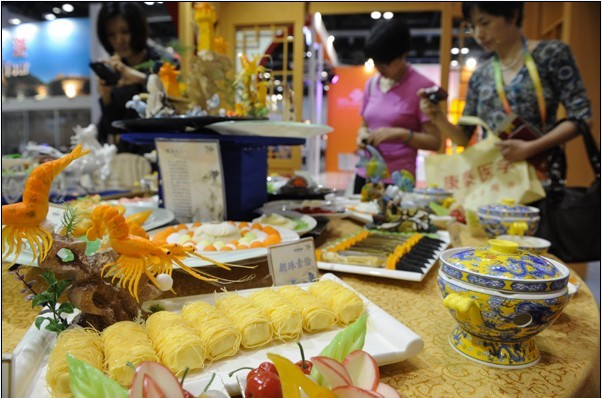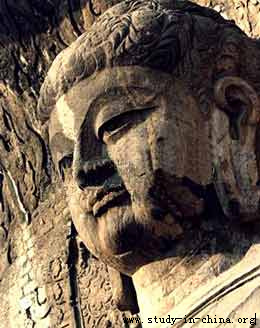| Home > China Feature |
Back-through Chuan
Tongbei Quan or back-through Chuan, also called Tongbi Quan or arm-through Chuan, is one of the schools popular in north China. Due to its long history, it boasts of various names in different places, such as the Wuxing (five elements-metal, wood, water, fire and earth), six-combinations, five-monkey, axe-hitch and the Shaolin. Although there are different names, the different styles of Tangbei Quan are all based on the same Chuan theory and have the same origin. The major schools and styles of Tongbei Quan are as follows:
1. In 1937 Wu Tianxu wrote in his book Tongbei Quanshu that this school of Chuan had been called the back-through which was later changed to the white ape school and long-armed ape school. Qing Dynasty practitioners called it the traveling, traveling Chuan or Chang Quan.
2. Some say that Tongbei Quan was created in the period of the Five Dynasties or in the Song Dynasty. One theory is that it was created by Han Tong, recorded in some Chuan literature as one of the 18 Chuan masters of the ancient times. Another proposition says that it was created by Chen Tuan in the early Song Dynasty and in the middle of the Qing Dynasty Lu Yunqing taught it to Qi Taichang. In his book Wushu Theory, Xu Yusheng wrote that Chen Tuan, also called Chen Tu'nan, lived in seclusion in Mount Hua during the Five Dynasties. He could sleep for 100 days without getting up. Emperor Taizong of the Song Dynasty conferred a designation of Dr Xiyi on him. Chen was said to have created 12 sitting exercises.
3. Huang Zongxi, a well-known scholar of the Ming Dynasty, wrote in his Essay of Southern Thunderbolts, that Tongbei Quan was the best among all Chuan schools. Later, Huang Baijia in his biography of Dr Wang Zhengnan said that Tongbei Quan is Chang Quan or long-range Chuan. The arm-through Chuan can thus be said to have been popular in the Ming Dynasty.
4. According to the Chuan chronicles by Xiu Jianchi, Qi Xin of Zhejiang went to teach the back-through Chuan at Gu'an in Hebei Province in the middle and latter half of the Qing Dynasty. His style was then called Qi-style Chuan which was later named as Tongbei or back-through Chuan. Qi's son, Qi Taichang improved and developed the Chuan techniques. People then divided Tongbei Quan into an old style and a new one. The old style emphasizes simplicity and power whereas the new style concentrates on exquisiteness and suppleness. Many masters emerged in this school later. Tongbei Quan now in practice is generally divided into two styles. One has been passed down from Qi Xin, the father and the other from Qi Taichang, the son. Xiu Jianchi, a successor to the new style, combined the best elements of his predecessors and left his theoretical summaries on stances, methods and philosophy of the Chuan to his followers, Xiu's writings are precious materials for the study and research of Tongbei Quan.
Originally Tongbei did not refer to a school of Chuan but to a way of exercise. "Tong" means to pass through and reach, "Bei"means the human back. When the exercises are done, power is generated from the back to pass through the shoulders and then reach the arms. In this way, heavy blows can be delivered at the arm's length to control the opponent. Tongbei Quan emphasizes the combination of inner core and outward application. It takes the five elements as its core and back-through as its application. Back-through Chuan takes the five elements of traditional Chinese philosophy as its basic theory. This philosophy holds that the heaven is a big world while the human being is a small one. The five elements of the heaven are metal, wood, water, fire and earth while those of the human being the heart, liver, spleen, lung and kidney. The five elements of Chuan are wrestling, batting, piercing, axing and boring. The Chinese Chuan philosophy believes that everything in the world finds its roots in the five elements while all Chuan schools are also based on its five elements. The following table demonstrates the interrelations among the five elements of the heaven and those of the human being and Chuan:
Lung-metal-wrestling-exploding-lightening Liver-wood-batting-pushing-fog Kidney-water-piercing-hammering-star Heart-fire-axing-hitting-thunder bolt Spleen-earth-boring-tossing-arrow
Back-through Chuan is characterized by movements based on birds and animals-monkeys, eagles, cranes and cats.
Art
 more
moreChina Beijing International Diet ...
Recently, The hit CCTV documentary, A Bite of China, shown at 10:40 ...

Exhibition of Ancient Chinese Jad...
At least 8,000 years ago, Chinese ancestors discovered a beautiful...

Longmen Grottoes
The Longmen Grottoes, located near Luoyang, Henan Province, are a tr...

Custom
 more
moreWeb Dictionary
Martial Arts
Tai Chi Master Class Held in Moscow
MOSCOW, June 15, 2016 (Xinhua) -- Students learn from Shaolin ...
Celebriting 70 years' efforts in restoring Mogao...
Work is being carried out at the restoration site of cave No 98 a...
Hong Kong Children's Symphony performs in Seattle
Under the theme of Tribute to the Golden Age, a concert featuring a ...





 print
print  email
email  Favorite
Favorite  Transtlate
Transtlate 








